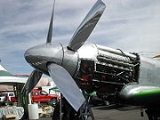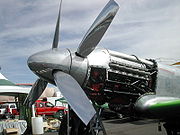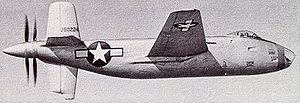
Contra-rotating propellers
Encyclopedia

Turboprop
A turboprop engine is a type of turbine engine which drives an aircraft propeller using a reduction gear.The gas turbine is designed specifically for this application, with almost all of its output being used to drive the propeller...
engine to drive two propellers
Propeller (aircraft)
Aircraft propellers or airscrews convert rotary motion from piston engines or turboprops to provide propulsive force. They may be fixed or variable pitch. Early aircraft propellers were carved by hand from solid or laminated wood with later propellers being constructed from metal...
in contra-rotation (rotation about the same axis in opposite directions). Two propellers are arranged one behind the other, and power is transferred from the engine via a planetary gear or spur gear transmission
Transmission (mechanics)
A machine consists of a power source and a power transmission system, which provides controlled application of the power. Merriam-Webster defines transmission as: an assembly of parts including the speed-changing gears and the propeller shaft by which the power is transmitted from an engine to a...
. Contra-rotating propellers should not be confused with counter-rotating propellers
Counter-rotating propellers
Counter-rotating propellers, found on twin- and multi-engine propeller-driven aircraft, spin in directions opposite one another.The propellers on both engines of most conventional twin-engined aircraft spin clockwise . Counter-rotating propellers generally spin clockwise on the left engine and...
—airscrews on different engines turning opposite directions.
Operation
When airspeed is low, the massMass
Mass can be defined as a quantitive measure of the resistance an object has to change in its velocity.In physics, mass commonly refers to any of the following three properties of matter, which have been shown experimentally to be equivalent:...
of the air flowing through the propeller disk (thrust
Thrust
Thrust is a reaction force described quantitatively by Newton's second and third laws. When a system expels or accelerates mass in one direction the accelerated mass will cause a force of equal magnitude but opposite direction on that system....
) causes a significant amount of tangential or rotational air flow to be created by the spinning blades. The energy of this tangential air flow is wasted in a single-propeller design. To use this wasted effort the placement of a second propeller behind the first takes advantage of the disturbed airflow. The tangential air flow also causes handling problems at low speed as the air strikes the vertical stabilizer
Vertical stabilizer
The vertical stabilizers, vertical stabilisers, or fins, of aircraft, missiles or bombs are typically found on the aft end of the fuselage or body, and are intended to reduce aerodynamic side slip. It is analogical to a skeg on boats and ships.On aircraft, vertical stabilizers generally point upwards...
, causing the aircraft to yaw left or right, depending of the direction of propeller rotation.
If it is well designed, a contra-rotating propeller will have no rotational air flow, pushing a maximum amount of air uniformly through the propeller disk, resulting in high performance and low induced energy loss. It also serves to counter the asymmetrical torque
Torque
Torque, moment or moment of force , is the tendency of a force to rotate an object about an axis, fulcrum, or pivot. Just as a force is a push or a pull, a torque can be thought of as a twist....
effect of a conventional propeller (see P-factor
P-factor
P-factor, also known as asymmetric blade effect and asymmetric disc effect, is an aerodynamic phenomenon experienced by a moving propeller, that is responsible for asymmetrical relocation of the propeller's center of thrust when aircraft is at a high angle of attack.- Causes :When an aircraft is in...
). Some contra-rotating systems were designed to be used at take off for maximum power and efficiency under such conditions, and allowing one of the propellers to be disabled during cruise to extend flight time.
Contra-rotating propellers have been found to be between 6% and 16% more efficient than normal propellers. However they can be very noisy, with increases in noise in the axial (forward and aft) direction of up to 30 dB, and tangentially 10 dB. Most of this extra noise can be found in the higher frequencies. These substantial noise problems will limit commercial applications unless solutions can be found. One possibility is to enclose the contra-rotating propellers in a shroud. It is also helpful if the two propellers have a different number of blades (e.g. four blades on the forward propeller and five on the aft).
The efficiency of a contra-rotating prop is somewhat offset by its mechanical complexity. Nonetheless, coaxial contra-rotating propellers and rotors are moderately common in military aircraft
Military aircraft
A military aircraft is any fixed-wing or rotary-wing aircraft that is operated by a legal or insurrectionary armed service of any type. Military aircraft can be either combat or non-combat:...
.
Significant aircraft
While several nations experimented with contra-rotating propellers in aircraft, only the United Kingdom and Soviet Union produced them in large numbers. The first aircraft to be fitted with a contra-rotating propeller to fly though was in the US when two inventors from Ft Worth, Texas tested the concept on an aircraft.United Kingdom
Some of the more successful British aircraft with contra-rotating propellers are the Avro ShackletonAvro Shackleton
The Avro Shackleton was a British long-range maritime patrol aircraft for use by the Royal Air Force. It was developed by Avro from the Avro Lincoln bomber with a new fuselage...
, powered by the Rolls-Royce Griffon
Rolls-Royce Griffon
The Rolls-Royce Griffon is a British 37-litre capacity, 60-degree V-12, liquid-cooled aero engine designed and built by Rolls-Royce Limited...
engine, and the Fairey Gannet
Fairey Gannet
The Fairey Gannet was a British carrier-borne anti-submarine warfare and airborne early warning aircraft of the post-Second World War era developed for the Royal Navy's Fleet Air Arm by the Fairey Aviation Company...
, which used the Double Mamba Mk.101 engine.
Later variants of the Supermarine Spitfire
Supermarine Spitfire
The Supermarine Spitfire is a British single-seat fighter aircraft that was used by the Royal Air Force and many other Allied countries throughout the Second World War. The Spitfire continued to be used as a front line fighter and in secondary roles into the 1950s...
and Seafire used the Griffon with contra-rotating props as well. In the Spitfire/Seafire and Shackleton's case the primary reason for using contra-rotating propellers was so as to increase the propeller blade-area, and hence absorb greater engine power, within a propeller diameter limited by the height of the aircraft's undercarriage
Undercarriage
The undercarriage or landing gear in aviation, is the structure that supports an aircraft on the ground and allows it to taxi, takeoff and land...
. Whilst this also applied to the Gannet, in addition this aircraft's engine had two separate power-sections, each driving one propeller. The Short Sturgeon
Short Sturgeon
The Short Sturgeon was a British aircraft originally designed in the Second World War as a high-performance torpedo bomber. With the end of the war in the Pacific it was no longer needed as such. Through shifting priorities postwar, the Sturgeon was redesigned first into a target tug and then later...
used 2 Merlin 140s with contra-rotating propellers.
The Bristol Brabazon
Bristol Brabazon
The Bristol Type 167 Brabazon was a large propeller-driven airliner, designed by the Bristol Aeroplane Company to fly transatlantic routes from the United Kingdom to the United States. The prototype was delivered in 1949, only to prove a commercial failure when airlines felt the airliner was too...
prototype airliner used eight Bristol Centaurus
Bristol Centaurus
|-See also:-Bibliography:*Bridgman, L, Jane's Fighting Aircraft of World War II. Crescent. ISBN 0-517-67964-7*Gunston, Bill. Development of Piston Aero Engines. Cambridge, England. Patrick Stephens Limited, 2006. ISBN 0-7509-4478-1...
engines driving four pairs of contra-rotating propellers, each engine driving a single propeller.
USSR, Russia and Ukraine
In the 1950s, the Soviet Union developed the Kuznetsov NK-12Kuznetsov NK-12
-See also:-External links:*...
turboprop. It drives an 8-blade contra-rotating propeller and, at 15,000 shp, it is the most powerful turboprop in the world. Four NK-12 engines power the Tupolev Tu-95
Tupolev Tu-95
The Tupolev Tu-95 is a large, four-engine turboprop-powered strategic bomber and missile platform. First flown in 1952, the Tu-95 entered service with the former Soviet Union in 1956 and is expected to serve the Russian Air Force until at least 2040...
Bear, the only turboprop bomber to enter service, as well as one of the fastest propeller-driven aircraft
Fastest propeller-driven aircraft
A number of aircraft have claimed to be the fastest propeller-driven aircraft. This article presents the current record holders for several sub-classes of propeller-driven aircraft that hold recognized, documented speed records. Fédération Aéronautique Internationale records are the basis for this...
. The Tu-114
Tupolev Tu-114
The Tupolev Tu-114 Rossiya is a turboprop-powered long-range airliner designed by the Tupolev design bureau and built in the USSR from May 1955....
, an airliner derivative of the Tu-95, holds the world speed record for propeller aircraft. The Tu-95 was also the first Soviet bomber to have intercontinental range. The Tu-126
Tupolev Tu-126
|-See also:-Bibliography:*Duffy, Paul and Kandalov, Andrei. Tupolev: The Man and His Aircraft. Shrewsbury, UK:Airlife, 1996. ISBN 1 85310 728 X....
AEW aircraft and Tu-142
Tupolev Tu-142
The Tupolev Tu-142 is a maritime reconnaissance and anti-submarine warfare aircraft derived from the Tu-95 turboprop strategic bomber. A specialised communications variant designated Tu-142MR was tasked with long-range communications duties with Soviet ballistic missile submarines...
maritime patrol aircraft are two more NK-12 powered designs derived from the Tu-95.
The NK-12 engine powers another well-known Soviet aircraft, the Antonov An-22
Antonov An-22
The Antonov An-22 Antei was the world's heaviest aircraft, until the advent of the American C-5 Galaxy and later the Soviet An-124. Powered by four pairs of contra-rotating turboprops, the design remains the world's largest turboprop-powered aircraft...
Antheus, a heavy-lift cargo aircraft. At the time of its introduction, the An-22 was the largest aircraft in the world and is still by far the world's largest turboprop-powered aircraft. From the 1960s through the 1970s, it set several world records in the categories of maximum payload-to-height ratio and maximum payload lifted to altitude.
Of lesser note is the use of the NK-12 engine in the A-90 Orlyonok
A-90 Orlyonok
-External links:* * * * * *...
, a mid-size Soviet ekranoplan. The A-90 uses one NK-12 engine mounted atop its T-tail, along with two turbojets nestled in its nose.
In 1994, Antonov produced the An-70
Antonov An-70
The Antonov An-70 is a four-engine medium-range transport aircraft, and the first large aircraft to be powered by propfan engines. It is being developed by Ukraine's Antonov design bureau to replace the obsolete An-12 military transport aircraft...
, a heavy transport aircraft. It is powered by four Progress D-27
Progress D-27
-See also:- External links :*...
propfan
Propfan
A propfan was first defined as a small diameter, highly loaded multiple bladed variable pitch propulsor having swept blades with thin advanced airfoil sections, integrated with a nacelle contoured to retard the airflow through the blades thereby reducing compressibility losses and designed to...
engines driving contra-rotating propellers. The characteristics of the D-27 engine and its propeller make it a propfan, a hybrid between a turbofan engine and a turboprop engine.
United States

XP-56 Black Bullet
|-See also:-References:NotesBibliography* Allen, R.S. The Northrop Story. New York: Orion, 1990. ISBN 0-517-56677-4.* Andersen, Fred. Northrop - An Aeronautical History: a Commemorative Book Edition of Airplane Designs and Concepts. Century City, California: Northrop Corporation, 1976. Library of...
and the tail-sitting
Tailsitter
A tailsitter is a type of VTOL aircraft that launches and lands on its tail. One of the most famous examples of this type of aircraft is the Ryan X-13 Vertijet. Among the propeller-driven versions were the Lockheed XFV, and the Convair XFY Pogo. Studies and wind tunnel models were made of a...
Convair XFY
Convair XFY
|-See also:-References:NotesCitationsBibliography* Allen, Francis J. "Bolt Upright: Convair's and Lockheed's VTOL fighters". Air Enthusiast Volume 127, January/February 2007, pp. 13–20. ISSN 0143-5450....
and Lockheed XFV
Lockheed XFV
-See also:-References:NotesCitationsBibliography* Allen, Francis J. "Bolt upright: Convair's and Lockheed's VTOL fighters". Air Enthusiast , Volume 127, January/February 2007, pp. 13–20. ISSN 0143-5450....
"Pogo" VTOL fighters and the Hughes XF-11 reconnaissance plane, but jet engine
Jet engine
A jet engine is a reaction engine that discharges a fast moving jet to generate thrust by jet propulsion and in accordance with Newton's laws of motion. This broad definition of jet engines includes turbojets, turbofans, rockets, ramjets, pulse jets...
technology was advancing rapidly and the designs were deemed unnecessary.
Ultralight applications
An Austrian company, Sun Flightcraft, distributes a contra-rotating gearbox for use on Rotax 503Rotax 503
|-Specifications :...
and 582
Rotax 582
|-Specifications :-External links:*...
engines on ultralight and microlight aircraft. The Coax-P allows powered hang-gliders and parachutes to develop 15 to 20 percent more power while reducing torque moments. The manufacturer also reports reduced noise levels from dual contra-rotating props using the Coax-P gearbox.
External links
- Two Propellers in Tandem Turning in Opposite Ways Give Warplane New Speed 1941 article with text, photos and drawing
- Aircraft.co.za - The Complete Aviation Reference
- Luftfahrtmuseum.com - Further information and pictures of contra rotators for the Fairey Gannet and Shackleton
- http://youtube.com/watch?v=FbgpH2nrn-A&feature=relatedVideo of a Spitfire PR.XIXSupermarine SpitfireThe Supermarine Spitfire is a British single-seat fighter aircraft that was used by the Royal Air Force and many other Allied countries throughout the Second World War. The Spitfire continued to be used as a front line fighter and in secondary roles into the 1950s...
Startup by Steve Hinton at Chino, California on YouTube]

